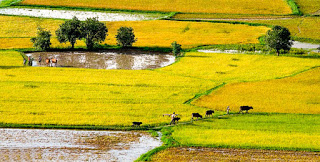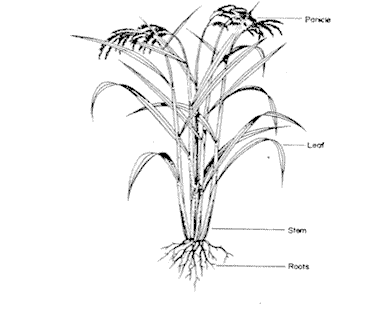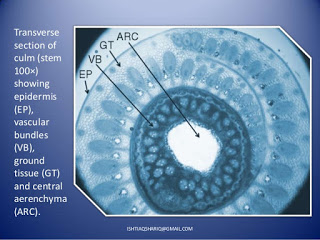Biology
 There are many varieties of rice and they differ in their water requirements. Most of the rice in south-east Asia is grown in unusual conditions for a cereal plant. It is grown partly submerged in water in paddy fields.
There are many varieties of rice and they differ in their water requirements. Most of the rice in south-east Asia is grown in unusual conditions for a cereal plant. It is grown partly submerged in water in paddy fields.
The fields are flooded and then ploughed. Young rice plants are planted in the rich mud formed in these paddy fields. The oxygen concentration of this mud fails rapidly after the paddy field has been flooded. The top ten centimetres or so retains some oxygen because it is able to diffuse in but below this depth anaerobic conditions exist and there is little or no oxygen present.
Rice plants have a number of adaptations which enable them to grow well in these conditions.
Rice stems contain a large number of air spaces (hollow aerenchyma) running the length of the stem and into the roots. This allows oxygen (some formed in the plant from photosynthesis) to penetrate through to the roots which are submerged in water, supplying oxygen for aerobic respiration. This decreases the chance that anaerobic respiration will occur.

When fields in which a cereal such as wheat is growing are flooded for any length of time, the plants die. The oxygen concentration of the waterlogged soil falls rapidly. The root cells are unable to get the oxygen they need in order to respire. In these conditions they can carry on respiring without oxygen. This is called anaerobic respiration and results in ethanol being formed as a waste product. Unfortunately, this substance is poisonous so a plant can only respire in this way for a short time before the ethanol concentration builds up and kills it.
There are two advantages of growing rice in paddy fields. Flooding brings about chemical changes in the soil which increases the supply of soil nutrients required by the rice plants. It also reduces weeds. Rice does not grow well when it has to compete with weeds for the resources that it needs.
Source: Cix.co.uk
- Alcohol Fermentation
This beer was once made through alcohol fermentation! Alcohol fermentation is a process used in brewing, winemaking, and baking. The product of alcohol fermentation is ethanol which is toxic to the organism that produces it. Therefore, yeasts release...
- # 91 Anaerobic Respiration - Ethanol And Lactate Pathways
Anaerobic respiration is a type of respiration that does not use oxygen. It is used when there is not enough oxygen for aerobic respiration. In the absence of free oxygen: Oxidative phosphorylation cannot take place, as there is nothing to accept...
- #87 Respiration, Glycolysis
Respiration is the oxidation of energy-containing organic molecules. The energy released from this process is used to combine ADP with inorganic phosphate to make ATP. All cells obtain useable energy through respiration. Most cells use carbohydrate,...
- #38.2 Transport In Multicellular Plants - Syllabus 2016
7.1 Structure of transport tissues 7.2 Transport mechanisms Flowering plants do not have compact bodies like those of animals. Leaves and extensive root systems spread out to obtain the light energy, water, mineral...
- Photosynthesis And Cellular Respiration
Photosynthesis is the processes of converting carbon dioxide and water, using light energy, into glucose and oxygen. Plants, algae, and certain prokaryotes capture about 1% of the energy in the sunlight that reaches Earth and convert it to chemical energy...
Biology
#95 Rice adaptation for growing with its roots submerged in water

The fields are flooded and then ploughed. Young rice plants are planted in the rich mud formed in these paddy fields. The oxygen concentration of this mud fails rapidly after the paddy field has been flooded. The top ten centimetres or so retains some oxygen because it is able to diffuse in but below this depth anaerobic conditions exist and there is little or no oxygen present.
Rice plants have a number of adaptations which enable them to grow well in these conditions.
Rice stems contain a large number of air spaces (hollow aerenchyma) running the length of the stem and into the roots. This allows oxygen (some formed in the plant from photosynthesis) to penetrate through to the roots which are submerged in water, supplying oxygen for aerobic respiration. This decreases the chance that anaerobic respiration will occur.
 |
| ARC - Central aerenchyma in the rice stem. |
Many of rice roots are very shallow, allowing access to oxygen that diffuses into the surface layer of the waterlogged soil.

Cells in the roots of rice plants have been shown to be extremely tolerant of ethanol, much more so than cells from the roots of other cereals. They can therefore respire anaerobically for longer periods. When oxygen levels fall too low, the young rice plants can respire anaerobically, producing ethanol. Ethanol is normally toxic to cells, but the root cells of rice have an unusually high tolerance to it ? they have a high concentration of the enzyme alcohol dehydrogenase in their cells. Adult plant roots are as intolerant of flooding as any other crop.
There are two advantages of growing rice in paddy fields. Flooding brings about chemical changes in the soil which increases the supply of soil nutrients required by the rice plants. It also reduces weeds. Rice does not grow well when it has to compete with weeds for the resources that it needs.
Source: Cix.co.uk
Syllabus: 12.2 Respiration l) explain how rice is adapted to grow with its roots submerged in water in terms of tolerance to ethanol from respiration in anaerobic conditions and the presence of aerenchyma |
- Alcohol Fermentation
This beer was once made through alcohol fermentation! Alcohol fermentation is a process used in brewing, winemaking, and baking. The product of alcohol fermentation is ethanol which is toxic to the organism that produces it. Therefore, yeasts release...
- # 91 Anaerobic Respiration - Ethanol And Lactate Pathways
Anaerobic respiration is a type of respiration that does not use oxygen. It is used when there is not enough oxygen for aerobic respiration. In the absence of free oxygen: Oxidative phosphorylation cannot take place, as there is nothing to accept...
- #87 Respiration, Glycolysis
Respiration is the oxidation of energy-containing organic molecules. The energy released from this process is used to combine ADP with inorganic phosphate to make ATP. All cells obtain useable energy through respiration. Most cells use carbohydrate,...
- #38.2 Transport In Multicellular Plants - Syllabus 2016
7.1 Structure of transport tissues 7.2 Transport mechanisms Flowering plants do not have compact bodies like those of animals. Leaves and extensive root systems spread out to obtain the light energy, water, mineral...
- Photosynthesis And Cellular Respiration
Photosynthesis is the processes of converting carbon dioxide and water, using light energy, into glucose and oxygen. Plants, algae, and certain prokaryotes capture about 1% of the energy in the sunlight that reaches Earth and convert it to chemical energy...
